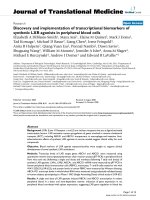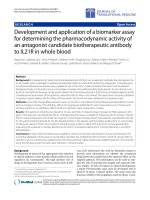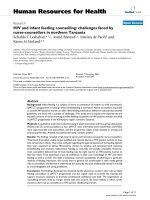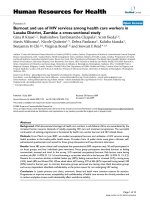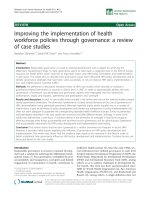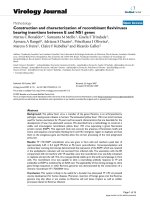Báo cáo sinh học: " Development and implementation of explicit computerized protocols for mechanical ventilation in children" pot
Bạn đang xem bản rút gọn của tài liệu. Xem và tải ngay bản đầy đủ của tài liệu tại đây (1023.63 KB, 26 trang )
This Provisional PDF corresponds to the article as it appeared upon acceptance. Fully formatted
PDF and full text (HTML) versions will be made available soon.
Development and implementation of explicit computerized protocols for
mechanical ventilation in children
Annals of Intensive Care 2011, 1:51 doi:10.1186/2110-5820-1-51
Philippe Jouvet ()
Patrice Hernert ()
Marc Wysocki ()
ISSN 2110-5820
Article type Review
Submission date 19 October 2011
Acceptance date 21 December 2011
Publication date 21 December 2011
Article URL />This peer-reviewed article was published immediately upon acceptance. It can be downloaded,
printed and distributed freely for any purposes (see copyright notice below).
Articles in Annals of Intensive Care are listed in PubMed and archived at PubMed Central.
For information about publishing your research in Annals of Intensive Care go to
/>For information about other SpringerOpen publications go to
Annals of Intensive Care
© 2011 Jouvet et al. ; licensee Springer.
This is an open access article distributed under the terms of the Creative Commons Attribution License ( />which permits unrestricted use, distribution, and reproduction in any medium, provided the original work is properly cited.
1
Development and implementation of explicit computerized protocols for mechanical
ventilation in children
Philippe Jouvet
1,2
, Patrice Hernert
2
,
and Marc Wysocki
2
1
Pediatric Intensive Care Unit, Department of Pediatrics, University of Montreal, Montreal,
Canada
2
Research Center, Sainte-Justine Hospital, University of Montreal, Montreal, Canada
*Corresponding author:
Email addresses:
PJ:
PH:
MW:
2
Abstract
Mechanical ventilation can be perceived as a treatment with a very narrow therapeutic
window, i.e., highly efficient but with considerable side effects if not used properly and in a
timely manner. Protocols and guidelines have been designed to make mechanical ventilation
safer and protective for the lung. However, variable effects and low compliance with use of
written protocols have been reported repeatedly. Use of explicit computerized protocols for
mechanical ventilation might very soon become a “must.” Several closed loop systems are
already on the market, and preliminary studies are showing promising results in providing
patients with good quality ventilation and eventually weaning them faster from the ventilator.
The present paper defines explicit computerized protocols for mechanical ventilation,
describes how these protocols are designed, and reports the ones that are available on the
market for children.
3
Introduction
Mechanical ventilation is a sophisticated technique that can keep alive the most severely ill
patients; however, it can simultaneously damage the lungs and unfortunately generate
unwanted complications [1]. By analogy with pharmacology, mechanical ventilation can be
viewed as a treatment with very narrow therapeutic windows, i.e., highly efficient but with
considerable side effects if not used properly and in a timely manner. During the past two
decades, considerable knowledge has been gained to find the optimal risk/benefit balance for
mechanical ventilation. For instance, protective ventilation with low tidal volume (VT) and
low airway pressure (Paw) has been shown to be safer than ventilation with high VT and Paw
in adults with ARDS [2]. However, several publications in adults and children have reported
variable effects of written protocols in implementing protective ventilation with relatively low
compliance with use of the protocols [3, 4] with a significant number of patients still being
ventilated with high VT and high Paw [5, 6]. Human and organizational factors are at least
partially responsible for such poor compliance [7] but so are the vast diversity of patient
types, conditions, and changes over time, which makes one protocol unable to fit all
situations.
In addition, expertise and human resources are not always available to make sure that patients
receive the best ventilation everywhere and all the time. The ability to make timely
adjustments of the ventilator according to the patient’s condition, without much inter-
caregiver variability, would certainly improve the safety and efficiency of mechanical
ventilation especially when resources and expertise are not at the bedside 24 hours per day. In
the present paper, we will define an explicit computerized protocol, describe how these
protocols are designed and developed currently, report the ones that are available on the
market for children, and propose some considerations for future developments in this field.
4
Definitions
A protocol is a document that is designed to guide decisions regarding diagnosis,
management, and treatment of specific medical situations. The protocol is based on the
medical knowledge acquired from physiological studies, expertise, or evidence and can be
generated by individuals or by consensus obtained from a group of physicians or experts.
Protocols often are not precise enough to generate a decision at the bedside in a specific
situation and thus significant inter-clinician variability in their application may exist.
An explicit protocol is designed to provide enough details to generate patient-specific therapy
instructions that can be performed by different clinicians with no inter-clinician variability
[8]. Important individualization of patient therapy can be preserved by explicit protocols when
they are driven by individual patient data. Considering the number of clinical situations and
inputs from a given patient, explicit protocols rapidly become so complex that computers are
required to integrate the large amount of information and provide specific answers to the user.
An explicit computerized protocol (ECP) is an explicit protocol supported by computer
science to apply the instruction for a given patient at a given time. ECP might be in a laptop
or integrated into the ventilator or monitoring device. The medical knowledge is usually
implemented in the ECP through “if … then” rules. For example: if the SpO
2
is <88%, then
increase FiO
2
by 10%. The rules can be more complex and based on a validated physiological
equation, such as the Otis equation [9] as used in IntelliVent™ (Hamilton, Bonaduz,
Switzerland).
A rule can be in an open or closed loop. The rule is an open-loop rule if it results in a
therapeutic or diagnostic recommendation displayed on the screen of a device for which
caregivers can agree whether to accept the recommendation. According to the previous
definitions, a clinical decision support system (CDSS) is defined as an ECP that uses two or
5
more items of patient data to generate case-specific recommendations through rules that are
only in open-loop [10].
As a step further, a rule that provides a recommendation of modification of the ventilator
setting and implements this modification without caregiver intervention is a rule in closed-
loop. Currently most of the ECPs used commercially for mechanical ventilation involve both
open and closed-loop ventilation rules. A closed-loop ECP is arbitrarily designated as an ECP
with at least one rule in closed-loop (Figure 1).
Why do we need explicit computerized protocols for mechanical
ventilation?
The human brain has a limited ability to incorporate data and information in decision making
and human memory can simultaneously retain and optimally utilize only seven plus or minus
two data constructs [11]. The amount of data that is retained is even less when caregivers are
working at night, with stress and/or time pressure. This limitation contrasts sharply with the
clinical reality in which hundreds of variables are encountered by the caregivers in the ICU
setting and decisions are made 24 hours per day. To prescribe mechanical ventilation,
numerous parameters are considered, including all physiological data provided by the
respirator, monitors, and clinical data from the charts on diagnosis and use of sedatives and
hemodynamic treatments. The mismatch between human ability and the vast amount of data
and information contributes to variation in clinical practice as decisions are made applying
different data constructs and different knowledge/expertise. In such a complex environment,
the help of an ECP is crucial to limit inter-caregiver variability. In a less complex
environment, the aviation industry confronted human factors responsible for accidents [12]
and decided decades ago to develop and implement closed-loop ECP in airplanes to improve
safety resulting in a model of safety management today. That being said, in the medical field,
6
the major limitation to developing ECP is to agree on which medical knowledge to
implement.
Development of explicit computerized protocols
A multidisciplinary approach is needed to generate an ECP; the team should include clinical
expert(s) in mechanical ventilation to generate the knowledge and validate ECP in a clinical
environment, computer scientists to design the ECP platform, biomedical engineers to
implement the ECP into medical devices (monitors and/or ventilators) and test ECP
robustness and reliability, and industry to finalize a product that will receive a European
Community marking (CE mark) and a U.S. marking (Food and Drug Administration (FDA))
approval.
Generation and validation of medical knowledge implemented in an ECP
The basic component of an ECP is a medical knowledge-based rule. In our clinical practice,
we continuously apply rules. If we take the previous example of the SpO
2
/FiO
2
rule,
caregivers modify FiO
2
according to SpO
2
routinely. An ECP will recommend (open-loop) or
do (closed-loop) in the same way, as soon as a valid SpO
2
is available. The ECP also will
define how often the FiO
2
can be changed, the amplitude of change, and add additional rules:
for example, define what will occur if FiO
2
is 100% and SpO
2
still below normal range.
The knowledge needed to develop an ECP able to manage the course of mechanical
ventilation in any ICU patient is vast and we all know that “the devil is in the details.” This
knowledge is based on published work on respiratory physiology, clinical observational
studies to describe current practice [6, 13], consensus conferences to define the specific
clinical decision points (for example when do pediatric intensivists consider that we should
switch from conventional mode to high-frequency ventilation mode in ARDS patients?) and
clinical trials to validate ECPs [4, 14, 15]. A step-by-step approach, including more than one
7
research center, is needed to develop valid, robust, and widely accepted ECPs. For example,
the medical knowledge acquired in the past two decades on weaning in pressure support mode
resulted in the development of SmartCare/PS™. SmartCare/PS™ was developed by one
research team, and more than a decade elapsed from conception to commercialization [16,
17]. ECPs based on SpO
2
/FiO
2
have already been developed for neonates and children and
need further clinical validation [14, 15].
To shorten development and validation times, one option would be to follow the same
development and validation process used in aviation by using a simulated flight environment
(wind, temperature…). Medical ECP would need virtual patients with realistic physiological
and pathological behaviors for developing and validating ECPs before clinical trials. Several
teams are already working on such platforms, although none are currently commercialized for
this purpose [18-20].
ECP platform
The five technical components (Figure 2) of an ECP are: 1) input data (entered manually or
captured electronically from devices); 2) a control unit that analyses the input data to generate
orders; 3) output data; 4) an interface that display a recommendation (open-loop) or
implements the setting modification (closed-loop); and 5) a virtual patient as mentioned
above.
In the SpO
2
/FiO
2
rule already described, the input data is patient SpO
2
, the control unit
analyses SpO
2
and selects the rule that corresponds to SpO
2
value (e.g., increase FiO
2
if SpO
2
is low, decrease FiO
2
if SpO
2
is high (knowing that oxyhemoglobin dissociation curve is flat
at SpO
2
> 97%), or no change if SpO
2
is in normal range), the output data is the FiO
2
suggestion displayed on a screen (open-loop) or a setting modification on the respirator
(closed-loop).
8
- The input data, whether entered manually by the clinician or captured by a medical
device, needs to be processed to discard artefacts and to be clinically relevant before
being sent to the control unit [21]. The key point is to input relevant, valid, robust, and
stable data for the ECP. For example, the weaning ECP for children (SmartCare/PS™,
Dräger, Germany) transforms real-time tidal volume, respiratory rate, and end tidal
PCO
2
(ET
PCO2
) into mean values during a 2-minute period. With IntelliVent™
(Hamilton Medical, Switzerland), the ET
PCO2
used for the minute ventilation closed-
loop is the second highest breath-by-breath ET
PCO2
with enough quality index during
the last 10 breaths [14]. On the other hand, ET
PCO2
is not always a good surrogate for
PaCO
2
especially during the acute phase of illness with high dead space. Such
situations must be detected by the ECP to avoid any misinterpretation of the input data.
- The control unit receives clinical information from the patient (input data) and
“transforms” this information into orders (output data). The basic structure for
processing information is rule-based (see above). All potential paths and situations
should be addressed to lead to specific instructions. It usually requires several set of
rules to manage two to three input data each. For example, a first set of rules could be
for pressure support management according to tidal volume, respiratory rate, and
ET
PCO2
[17], a second set of rules could be for FiO
2
and PEEP management according
to SpO
2
[22], and another set of rules could be for recommending extubation when
pressure support, PEEP, and FiO
2
reach threshold values for a certain length of time
(mimicking an extubation readiness test) [4]. Rules are usually “if … then …” rules, but
some ECPs have been developed using fuzzy logic [23], i.e., integrating patient’s
information in a fuzzy way to mimic the human brain [24, 25]. Despite the use of fuzzy
logic in aircraft autopilot and in various other applications [25], to the best of our
knowledge, fuzzy logic is not used in commercialized medical ECPs.
9
- Output data can be recommendations to the caregivers suggesting new ventilator
settings, specific orders such as “patient ready for separation from the ventilator,” or
ventilator settings being automatically adjusted. During the development phase of an
ECP, output data are usually recommendations (open-loop). After extensive testing,
some rules or sets of rules can be switched to close the loop.
- A simple, attractively presented, and intuitive user interface is crucial to facilitate the
understanding of the ECP decision process and for knowledge transfer at the bedside
[26]. Ideally, the user interface should include educational tools to train caregivers on
mechanical ventilation management according to the ECP, as done with simulators for
aircraft pilots.
- As mentioned above, use of a virtual patient mimicking patient-ventilator
cardiorespiratory interactions also is important for the development of ECPs. As for
aircraft autopilot, a virtual patient may help “debug” the very first ECP versions but
also aid understanding the complex interactions between rules and achieving
preclinical validation. In addition such virtual patients, which should ideally be
incorporated in the medical device (i.e., the ventilator), might be more efficient in
training and teaching the eventual users (Figure 2). Currently, the virtual patients used
for ECP development are computer simulations of the physiologic processes of
respiration and circulation, using mathematical models.
Several barriers exist to the development of ECPs: 1) We do not generate enough medical
knowledge in mechanical ventilation and most of the time ECPs are targeting a relatively
small and regional scientific community. This can be improved by promoting multicenter
international collaborations along the lines of the Pediatric Acute Lung Injury and Sepsis
Investigators Network (PALISI), the European Society of Pediatric Intensive Care Medicine
10
and Collaborative Critical Care Research Network (CCCRN) [5, 27]; 2) It is important to be
able to capture any refusal of an ECP recommendation and to analyse if an adjustment of the
ECP is mandatory. The commercialized ECP described below do not have such reporting
systems. In the future, the ECPs should be equipped with a data report system and an expert
team should analyze the data to refine the ECP. The versatility and the ease in upgrading and
adjusting the ECP are probably key factors in making ECP widely accepted; 3) The
manufacturers are unfortunately not ready to share their ECPs, processes and knowledge, for
obvious marketing and business reasons. They also may need more resources and less time-
to-market constraints to innovate further. Consortium(s) like those that exist in aeronautics
could be of considerable value in driving forward innovation in this field.
11
Several barriers also exist to the acceptance and implementation of ECPs. These barriers
include the lack of awareness, lack of familiarity with the protocol, lack of agreement, lack of
demonstrated safety and efficacy, lack of known improved outcome, lack of ability to
overcome the inertia of previous practice, protocol-related barriers (not easy to use, not
convenient, cumbersome, confusing), environment-related barriers (new resources
or facilities
not accessible) [8]. Among all these barriers, the safety issue is the first and most important
one. The safety issue is addressed using the three following principles: 1) ECPs suggests a
modification or modifies ventilation settings only within the alarms prescribed on the
respirator; 2) there are stop rules implemented in ECPs that interrupt closed loop protocols in
specific situations (if input data are not available for example); 3) Most of the ECPs in closed
loop are first developed and tested for the management of the weaning phase. Despite these
barriers many set of rules even in closed loop are widely accepted by caregivers. For example,
the algorithm of the neurally adjusted ventilatory assist mode (NAVA) includes a rule that
automatically adjusts positive inspiratory pressure to patient's electrical activity of the
diaphragm change to deliver ventilation proportional to patient’s needs.
Explicit computerized protocols for mechanical ventilation in children
Saxton and Myers reported the first ECP to adjust the end tidal PCO
2
by regulating the
negative pressure of an iron lung ventilator in poliomyelitis patients [28]. Pediatricians then
soon became concerned with tightly adjusting the FiO
2
tightly in order to avoid
hypo/hyperoxemia and their related side effects [29, 30]. Dugdale and coworkers [31]
reported in 1988 seven neonates with respiratory distress syndrome treated during 48 hours
with a closed-loop FiO
2
adjustment to keep the PaO
2
obtained from an indwelling umbilical
artery electrode at 10 kPa. The time spent by the neonates with PaO
2
at ±1 kPa of the target
PaO
2
was 75% with closed-loop control FiO
2
compared with 45% with manual adjustment of
FiO
2
. But the invasiveness of the PaO
2
monitoring precluded the development of this ECP.
12
Claure et al. conducted a research program designed to develop closed-loop FiO
2
adjustment
using SpO
2
[32, 33]. These authors recently conducted a multicenter, randomized, clinical
trial that included mechanically ventilated preterm infants who were ventilated during two
consecutive 24-hour periods: one with FiO
2
adjusted by caregivers and the other by an
automated system, in random sequence. Automated FiO
2
adjustment improved maintenance
of the intended SpO
2
range, and led, significantly, to reduced time with high SpO
2
and more
frequent episodes with SpO
2
between 80% and 86% [15]. This ECP is now commercialized as
CLiO2™ (CareFusion, Yorba Linda, US) and implemented in a respirator.
SmartCare/PS™ (Draeger Medical, Lübeck, Germany; PS stands for pressure support) is an
ECP for the closed-loop control of pressure support ventilation. This ECP operates without
the need of caregivers intervention but under their supervision (Figure 1), the four following
therapeutic procedures: 1) automatic adaptation of the pressure support level to keep the
patient inside a “zone of respiratory comfort” that corresponds to a respiratory pattern that is
determined by lower and upper thresholds of tidal volume, respiratory rate, and end tidal
PCO
2
. These thresholds are defined within acceptable limits as established by a large panel of
pediatric intensivists [34]; 2) a strategy to gradually and progressively decrease the level of
pressure support level; 3) an automated spontaneous breathing trial (SBT) when the patient
reaches a minimum ventilation support; and 4) a recommendation of separation from the
ventilator when the SBT is successfully passed (Table 1). SmartCare/PS™ is available on
Draeger’s Evita XL and the latest generation of Draeger Medical ventilators: Evita Infinity
V500. Among the first 20 pediatric patients treated with SmartCare/PS™, median time in
“zone of respiratory comfort” was 91% (range, 0.7–99%) [4]. In a single-center, randomized,
clinical trial (RCT), a significant decrease in weaning duration in the SmartCare/PS™ group
(n = 15) was observed compared with usual care (n = 15), without any modification in
13
weaning failure rates [35]. A multicenter RCT should be conducted because the benefit of
SmartCare/PS™ may vary from one PICU to another as suggested by studies done in adults
[16, 36]. The major strength of SmartCare/PS™ is the implementation of an ECP for
mechanical ventilation with a user-friendly interface that allows individual customization.
There are several improvements to consider for SmartCare/PS™: 1) children with IBW <15
kg are excluded. Therefore, another ECP is needed in the same PICU for infants <15 kg. 2)
PEEP and FiO
2
are not automatically adjusted by SmartCare/PS™ but are part of the
recommended criteria to initiate a spontaneous breathing trial (SBT).
IntelliVent™ (Hamilton Medical, Bonaduz, Switzerland) is an ECP for the automated control
of minute volume, PEEP, and FiO
2
in adaptive support ventilation (ASV). IntelliVent™
manages, with (open-loop) or without the need of caregivers intervention (closed-loop), the
four following weaning steps: 1) switch from control ventilation to spontaneous breathing
(specific to ASV mode); 2) automatic adaptation of the pressure to maintain the patient in a
range of respiratory rate, end tidal PCO
2
and SpO
2
; 3) an automated SBT when children reach
minimum ventilation support; and 4) a timer that shows SBT duration (Table 1). IntelliVent™
is available on the G5 and S1 generation ventilators from Hamilton Medical that continuously
monitor usual mechanical ventilation parameters plus ET
PCO2
and SpO
2
[14]. IntelliVent™ has
been assessed in one clinical trial on feasibility and safety in children during the weaning
phase. Fifteen children were included and IntelliVent™ was safe and kept patients with body
weight ≥7 kg in the “zone of respiratory comfort” comparably to PSV or ASV [14]. The
major strength of IntelliVent™ is the combination of an ECP and user-friendly interface that
allows a certain individual customization of the protocols, including automatic recruitment
maneuvers. There are several improvements to consider for IntelliVent™ in children: 1) at
present, there is not much clinical experience with ASV and this ECP in children; 2) children
14
with ideal body weight <7 kg are excluded, therefore, another ECP is needed in the same
PICU for younger children; 3) automatic PEEP adjustment needs additional validation; 4)
IntelliVent limits adjustments of PEEP in the case of hemodynamic instability based on the
presence of pulsus paradoxus on pulse oximetry waveform (heart lung index) [37, 38]. The
accuracy of the waveform assessment and the upper limits of PEEP adjustment need to be
validated in children.
New ECP developments
A research program designed to develop and validate an ECP for the management of
mechanical ventilation in children with acute lung injury is being conducted by a working
group of the PALISI network in collaboration with CCCRN. This program is based on the
following principles: the ECP will be an adaptation of a protocol already developed in adults
(ARDS Network); the applicable type of ventilation will be pressure control mode and high
frequency oscillatory (HFOV) mode. The computerized protocol will start at initiation of
ventilation. The basic structure of the protocol will be that of a closed-loop system with the
initial stage of design being open-loop, even for HFOV. The input data will include ventilator
data, ET
PCO2
, SpO
2
,
blood gases, and an automatic analysis of chest x-ray. The output data
will be ventilation settings modifications and specific recommendations. Several preliminary
studies are ongoing to refine the input data [13]. The ECP will be first developed on a laptop.
To retain simplicity, the design will be closed-loop, so the final product will require few
interventions from caregivers. A data report system will register the reason why the decision
was not approved during the open-loop phase and should register other data, including
accurate time and version of the protocol being used. Downloading the data should be
possible in a database format and iterative refinement will be performed by a consensus
15
committee. Preliminary data on the ECP has already been collected [6] and an ECP platform
is almost completed (Figure 3).
Conclusions
Considering the current context in the PICU (manpower shortages, increased complexity of
care, lack of specific knowledge, needs for quality, safety, and reproducibility), ECP for
mechanical ventilation will very soon be a “must.” Open-loop and decision support systems
allow too much room for inter-physicians variability and may not achieve the goal of
providing the best possible care. As in many other fields, safety and quality will be achieved
by closing the loop but allowing physicians to retain the role of supervisor, most directly
involved with the most severe or atypical patients. Several closed-loop systems are already on
the market, and preliminary studies have shown promising results in providing patients with
good quality ventilation and eventually weaning them faster from the ventilator.
16
Competing interests
PJ has a research salary from the “Fonds de Recherche du Québec – Santé” in respiratory
critical care. PJ’s research on virtual patient (SimulResp) is funded by a grant from the
“Natural Sciences and Engineering Research Council of Canada.” The clinical research
conducted by PJ on SmartCare™ was funded by the Research network of the “Fonds de
Recherche du Québec – Santé” and a Ventilator S1 Evita 4 was provided for research
purposes by Draeger Medical. The clinical research conducted by PJ on IntelliVent™ was
funded by a grant from Hamilton Medical, and a respirator S1 was provided for research
purposes by Hamilton Medical. PJ was invited twice to present the results of the clinical
research on IntelliVent™ at international meetings organized by Hamilton Medical. PJ also
had a respirator Servo i, provided for research purposes by Maquet Medical.
MW was the director of the Research and Development Department of Hamilton Medical.
MW is cosharing a patent on IntelliVent™ (WO/2007/085110 and WO/2007/085108).
PH’s salary came from grants from the Research network of the “Fonds de Recherche du
Québec – Santé” and the “Natural Sciences and Engineering Research Council of Canada.”
Authors’ contribution
PJ, PH, and MW drafted the manuscript. All authors read and approved the final manuscript.
Acknowledgments
The authors thank Catherine Farrell, MD, for help with the manuscript preparation.
17
References
1. Tobin MJ: Advances in mechanical ventilation. NEJM 2001, 344:1986–1996.
2. Putensen C, Theuerkauf N, Zinserling J, Wrigge H, Pelosi P: Meta-analysis: ventilation
strategies and outcomes of the acute respiratory distress syndrome and acute lung
injury. Ann Intern Med 2009, 151:566–576.
3. Randolph AG, Wypij D, Venkataraman ST, Hanson JH, Gedeit RG, Meert KL, et al: Effect
of mechanical ventilator weaning protocols on respiratory outcomes in infants and
children: a randomized controlled trial. JAMA 2002, 288:2561–2568.
4. Jouvet P, Farges C, Hatzakis G, Monir A, Lesage F, Dupic L, et al: Weaning children
from mechanical ventilation with a computer-driven system (closed-loop protocol): a
pilot study. Pediatr Crit Care Med 2007, 8:425–432.
5. Santschi M, Jouvet P, Leclerc F, Gauvin F, Newth CJ, Carroll CL, et al: Acute lung injury
in children: therapeutic practice and feasibility of international clinical trials. Pediatr
Crit Care Med 2010, 11:681–689.
6. Khemani RG, Sward K, Morris A, Dean JM, Newth CJ: Variability in usual care
mechanical ventilation for pediatric acute lung injury: the potential benefit of a lung
protective computer protocol. Intensive Care Med 2011. Epub 2011/10/04.
7. Rubenfeld GD: Implementing effective ventilator practice at the bedside. Curr Opin
Crit Care 2004, 10:33–39.
8. Morris AH: Developing and implementing computerized protocols for standardization
of clinical decisions. Ann Intern Med 2000, 132(5):373–383.
9. Otis A, Fenn W, Rahn H: Mechanics of breathing in man. J Appl Physiol 1950, 2:592–
607.
10. Wyatt J: Computer-based knowledge systems. Lancet 1991, 338:1431–1436.
18
11. Miller G: The magical number seven plus or minus two: some limits on our capacity
for processing information. Psychol Rev 1956, 63:81–97.
12. Higton P: Safety lessons from aviation. Perfusion 2005, 20:191–193.
13. Eddington A, Jouvet P, Bordessoule A, Emeriaud G, Bruschschwein F, Wysocki M:
Invasive versus non-invasive criteria ventilator setting modification in critically ill
children. Pediatr Crit Care Med 2011, 12(Suppl 3):A78.
14. Jouvet P, Eddington A, Bordessoule A, Emeriaud G, Lopez Gasco R, Wysocki M:
Weaning children from mechanical ventilation with an explicit computerized protocol:
Intellivent
®
. Pediatr Crit Care Med 2011, 12(Suppl 3):A38.
15. Claure N, Bancalari E, D'Ugard C, Nelin L, Stein M, Ramanathan R, et al: Multicenter
crossover study of automated control of inspired oxygen in ventilated preterm infants.
Pediatrics 2011, 127:e76–e83.
16. Lellouche F, Mancebo J, Jolliet P, Roeseler J, Schortgen F, Dojat M, et al: A multicenter
randomized trial of computer-driven protocolized weaning from mechanical ventilation.
Am J Respir Crit Care Med 2006, 174:894–900.
17. Dojat M, Brochard L, Lemaire F, Harf A: A knowledge-based system for assisted
ventilation of patients in intensive care units. Int J Clin Monit Comput 1992, 9:239–250.
18. Sailors RM, East TD: A model-based simulator for testing rule-based decision support
systems for mechanical ventilation of ARDS patients. Proc Annu Symp Comput Appl Med
Care 1994, 1007.
19. Winkler T, Krause A, Kaiser S: Simulation of mechanical respiration using a
multicompartment model for ventilation mechanics and gas exchange. Int J Clin Monit
Comput 1995, 12:231–239.
20. Jouvet P: Un simulateur reproduit les réactions d’un patient pour l’assistance
respiratoire. Vecteur 2011, 10:1.
19
21. Tehrani FT, Roum JH: Intelligent decision support systems for mechanical ventilation.
Artif Intell Med 2008, 44:171–182.
22. Lellouche F, Hernert P, Jouvet P, Bouchard P, Brochard L: Clinical evaluation of a
computer-driven algorithm to automatically set PEEP and FiO2 during mechanical
ventilation. Am J Respir Crit Care Med 2009, 179:A3652.
23. Olliver S, Davis GM, Hatzakis GE: Weaning infants with respiratory syncytial virus
from mechanical ventilation through a fuzzy-logic controller. AMIA Annu Symp Proc
2003, 499–503.
24. Bates JH, Young MP: Applying fuzzy logic to medical decision making in the intensive
care unit. Am J Respir Crit Care Med 2003, 167:948–952.
25. Jamshidi M: Tools for intelligent control: fuzzy controllers, neural networks and
genetic algorithms. Philos Transact A Math Phys Eng Sci 2003, 361:1781–1808.
26. Wysocki M, Brunner JX: Closed-loop ventilation: an emerging standard of care? Crit
Care Clin 2007, 23:223–240, ix.
27. Khemani RG, Newth CJ: The design of future pediatric mechanical ventilation trials
for acute lung injury. Am J Respir Crit Care Med 2010, 182(12):1465–1474.
28. Saxton GA, Jr., Myers G: A servomechanism for automatic regulation of pulmonary
ventilation. J Appl Physiol 1957, 11:326–328.
29. Beran AV, Taylor WF, Ackerman BD, Sperling DR, Strauss J: An automatic oxygen
control system for infants. Pediatrics 1971, 48:315–318.
30. Beddis IR, Collins P, Levy NM, Godfrey S, Silverman M: New technique for servo-
control of arterial oxygen tension in preterm infants. Arch Dis Child 1979, 54:278–280.
31. Dugdale RE, Cameron RG, Lealman GT: Closed-loop control of the partial pressure of
arterial oxygen in neonates. Clin Phys Physiol Meas 1988, 9:291–305.
20
32. Claure N, Gerhardt T, Everett R, Musante G, Herrera C, Bancalari E: Closed-loop
controlled inspired oxygen concentration for mechanically ventilated very low birth
weight infants with frequent episodes of hypoxemia. Pediatrics 2001, 107:1120–1124.
33. Claure N, D'Ugard C, Bancalari E: Automated adjustment of inspired oxygen in
preterm infants with frequent fluctuations in oxygenation: a pilot clinical trial. J Pediatr
2009, 155:640–645 e1-2.
34. Santschi M, Gauvin F, Hatzakis G, Lacroix J, Jouvet P: Acceptable respiratory
physiologic limits for children during weaning from mechanical ventilation. Intensive
Care Med 2007, 33:319–325.
35. Jouvet P, Payen V, Gauvin F, Santschi M, Eddington A, Lacroix J: Weaning children
from mechanical ventilation with a computer-driven explicit protocol: a randomized
clinical trial. Am J Respir Crit Care Med 2010, 181:A3899.
36. Rose L, Presneill JJ, Johnston L, Cade JF: A randomised, controlled trial of
conventional versus automated weaning from mechanical ventilation using
SmartCare/PS. Intensive Care Med 2008, 34:1788–1795.
37. Michard F, Chemla D, Richard C, Wysocki M, Pinsky MR, Lecarpentier Y, et al: Clinical
use of respiratory changes in arterial pulse pressure to monitor the hemodynamic effects
of PEEP. Am J Respir Crit Care Med 1999, 159:935–939.
38. Feissel M, Teboul JL, Merlani P, Badie J, Faller JP, Bendjelid K: Plethysmographic
dynamic indices predict fluid responsiveness in septic ventilated patients. Intens Care
Med 2007, 33:993–999.
39. Jouvet P, Mersmann S, Wysocki M: Automation of weaning in children. In Textbook on
Pediatric and Neonatal Mechanical Ventilation. Edited by Rimensberger P. New York:
Springer Verlag; 2012: in press.
21
Figure 1. Schematic representation of the different processes for decision making. (A)
Actual caregiver decision making. (B) Explicit computerized protocol in open-loop (clinical
decision support systems). (C) Explicit computerized protocols in closed-loop.
Figure 2. The five components of a platform for development of an explicit
computerized protocol (input data, controller, output data, graphic interface, virtual
patient). The explicit computerized platform collects the data from the patient (SpO
2
, ET
PCO2
,
ventilation data…) and processes the data to determine new ventilator settings in open- or
closed-loop (output data). The virtual patient simulates the breathing pattern and the resulting
blood gases for a mechanically ventilated patient with predefined characteristics (age, body
weight, lung compliance, cardiac output, ventilator settings…). This virtual patient helps to
test a large panel of clinical situations to validate the rules implemented and to detect any
bugs.
Figure 3. Example of a platform for development of an explicit computerized protocol
dedicated to the management of mechanical ventilation in children with acute lung
injury that includes a virtual patient (named SimulResp) connected to a platform where
rules are implemented (personal data).
22
Table 1. Characteristics of the SmartCare/PS
™
Draeger Medical and IntelliVent
™
Hamilton
Medical explicit computerized protocols. Adapted from Jouvet et al. [39]
Characteristics SmartCare/PS™ IntelliVent™
Ventilation mode PSV ASV
Type of breath PS PC and PS
Body weight range for use ≥15 kg ≥7 kg
Primary goal of the ECP wean while maintaining maintaining
ET
PCO2
, RR, Vt ET
PCO2
,
RR, Vt, SpO
2
within predefined range within predefined ranges
Initial settings IBW, humidification system, IBW, medical history
medical history
Clinical decision support No Yes
Option (open-loop)
Input data
2min
ET
PCO2
,
2min
RR,
2min
Vt, ET
PCO2
, RR, Vt, SpO
2
PEEP, PS level, PEEP, PIP, breath by breath
Output data PS level, MV, PEEP, FiO
2
SBT Yes Yes
Recommendation for separation Yes SBT duration displayed
from the ventilator
PS, pressure support; PC, pressure controlled; ASV, adaptive support ventilation; IBW, ideal
body weight; Vt, tidal volume; RR, respiratory rate; ET
PCO2
, end tidal PCO
2
; SpO
2
, pulse
oxygen saturation;
2min
Vt,
2min
RR, or
2min
ET
PCO2
, mean value on 2 min of Vt, RR, or ET
PCO2
;
MV, minute volume; PEEP, positive end expiratory pressure; FiO
2
, inspired fraction of
oxygen; PIP, positive inspiratory pressure; SBT, spontaneous breathing trial.
" "
" " "
"
"
" "
" "
"
"
"
" " "
"
" "
" "
" "
" " "
"
"
" "
" "
"
"
"
" " "
"
" "
" "
Figure 1
Figure 2
